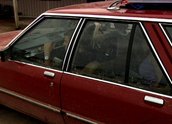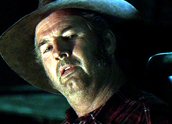


Wolf Creek (2005)
Synopsis
Three young backpackers buy a car in Broome, Western Australia, intending to drive across the top end to Cairns. Ben Mitchell (Nathan Phillips) is Australian; the two women, best friends Liz Hunter (Cassandra Magrath) and Kristy Earl (Kestie Morassi), are English. They don’t know Ben well, but he and Liz fancy each other. At the end of their first day in the desert, their car breaks down at a deserted tourist site – the large crater of a meteorite. They are relieved to be rescued in the night by a real outback character, Mick Taylor (John Jarratt). He tows them to his isolated camp at an abandoned mine site, promising to fix their car. All three tourists fall asleep. When Liz wakes up, she is bound and gagged and her friends are missing. Mick Taylor turns out not to be so friendly, after all.
Curator’s notes
Wolf Creek is not directly based on a true story, although a title at the start says, 'based on actual events’. It was suggested partly by the gruesome details of the backpacker murders committed by Ivan Milat in the 1990s, but these murders were committed in a state forest near Sydney. Wolf Creek relocated its killing spree to a much more foreboding and lonely landscape in the Australian desert, partly because it wanted the power of isolation, and partly because it’s about the myth of the friendly Aussie bushman, typified by Paul Hogan as Mick Dundee.
Mick Taylor is the evil inversion of Hogan’s tourism-building knockabout Northern Territory bloke. A former professional shooter, Taylor likes nothing better than to shoot the unsuspecting tourists brought his way by Dundee’s international success. He does it cheerfully and with a great sense of humour. That’s part of the success of John Jarratt’s memorable performance, in the best part of his long career. Taylor is a chuckling monster, who talks to his victims in the same avuncular way whether he’s fixing their cars, or tying them to a pole for the purpose of torture. He’s hardly the first outback killer in Australian cinema, but he’s certainly the most distinctive. He has a likeable personality, except for the fact that he’s a serial killer and rapist. That’s part of the skill of Jarratt’s performance, which presents Mick as a master of artifice. The 'friendly bloke’ who’s a bit of a yokel is a persona he uses to create trust, but the killer beneath is also like that – just a great deal more brutal. His vengeance is partly on tourists who think he’s the dumb hick he’s playing (though he’d kill people who didn’t think that, as well).
There’s a direct line back to characters Jarratt has played before. Wolf Creek is partly a much more nasty and violent reinvention of the plot of Picnic at Hanging Rock. That’s why the trouble begins at the meteorite crater, a place with a suggestion of supernatural power. Jarratt’s character in Picnic at Hanging Rock was under suspicion over the disappearance of schoolgirls. Wolf Creek removes the doubt, in a sense.
The film was an astonishingly confident debut for artist-turned-filmmaker Greg McLean. It’s one of the more visually sophisticated – and beautifully shot – films of the last ten years. Cinematographer Will Gibson persuaded McLean to shoot the film on high definition digital, rather than mini-DV, his original intention. The HD gives the film an almost metallic clarity with exceptional contrast, which succeeds in making the Australian outback – so familiar on film – look quite newly minted. It also makes the night scenes in the camp that much scarier, with deeper blacks in the dark areas. The film is exceptionally well edited and scored – all of which was achieved on a very low budget (about $A1.5 million).
The fact that John Jarratt missed out on a nomination in the 2005 AFI awards for best actor, and that the film won nothing in the seven other categories in which it was nominated, is perhaps a sign of the disdain in which violent horror is held by the AFI voters, rather than a measure of the film’s quality.
- Overview
- Curator’s notes
- Video 3 clips

- Principal credits
- Find a copy
- Make a comment
- Map
- Add your review



